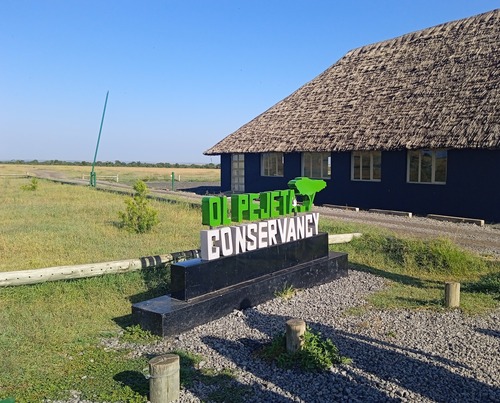Ol Pejeta Conservancy is a haven for protecting endangered species. Naicef highlights the best of Kenya’s Ol Pejeta Conservancy Nanyuki in this guide.
It is a well-known wildlife conservancy that has been appreciated for conserving endangered wildlife species.
Ol Pejeta Conservancy in Kenya is undeniably a top destination for nature enthusiasts. Its stunning landscapes and rich educational experiences make it valuable in Kenya’s tourism industry.
Moreover, it showcases the country’s commitment to wildlife conservation and attracts visitors from all over the world.
Contact Naicef via my@naicef.com or +254799922277 for the best deals to Kenya’s Ol Pejeta Conservancy or request a quote.
Naicef is the best tour company in Kenya to take you on a tour to Ol Pejeta Conservancy.
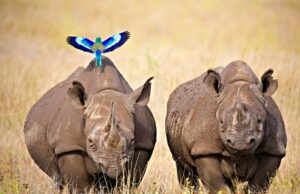
Interesting facts about Kenya’s Ol Pejeta Conservancy
The conservancy is home to one of the last two Northern White Rhinos and is a hub for research and innovation.
The name “Ol Pejeta” means a “place of burning”.
The Sweet Water’s Camp is a haven where Chimpanzees are taken care of. There is also a school-like section for the Chimpanzees. This is because the Chimpanzees are well-skilled in making items like humans.
There is a school for young Chimpanzees to teach them to coexist with the grown ones lest they get injured or even killed in their new home. The conservancy is a base for research and innovation.
Without disturbing animals in the conservancy, there are 10 infra-red cameras set up on wildlife pathways. The cameras monitthe or behaviour of the conservancy’s species. The insights are to help learn why and when they move to certain areas including the nocturnal animals.
The Conservancy has established the Mount Kenya Wildlife Estate to the east. The reason is to put up commercial housing with a dedicated conservation area for endangered herbivores.
The estate is to provide financial support to the conservancy for the short- and long-term goals. For assurance of freedom of movement for the residents, the estate if predator-proof. This also assures herbivores they have escaped being the predator’s meal.
At the entrance of the conservancy, there are souvenirs for purchase and information about the conservancy.
At the entrance of the Sweet Waters camp, on the walls, there are histories of how the Chimpanzees made their way to the conservancy and camp.
Feeding the chimpanzees costs $4,000, emphasizing their special nature. You can name a chimpanzee after yourself by following the rangers’ instructions.
There is a Global Gala for the Rhinos! Interesting, isn’t it?
Book with Naicef for the best deals to experience KenyaConservancya Conservancy.
What are the differences between Black and White Rhino?
- Black Rhinos live between 30-35 years in the wild. White Rhinos live between 40-50 years in the wild.
- Black Rhinos weigh 900 kg for females and 1,350 kg for males. White Rhinos weigh 2,000 kg females and males 2,500kg.
- Black Rhinos are solitary animals and are aggressive. White Rhinos are more social and calmer.
- Black Rhinos have a shoulder height of 1.6 M. White Rhinos have a shoulder height of 1.8 M.
- Black Rhinos have a pointy, triangular shaped mouth for browsing shrubs and leaves. White Rhinos have a wide, square mouth for grazing grass.
Best time to visit Ol Pejeta Conservancy Nanyuki Kenya
January to March are great months for experiencing lush landscapes and crystal-clear air and clearly sight the majestic Mount Kenya at a distance.
April to June is perfect for adventurous game drives and the conservancy is not crowded. During this time, there are plenty of attractions to see including big cats who avoid the wet grass.
July to September are dry seasons and perfect to view the Big Five and the grass levels are lower. Animals are mostly spotted at the waterholes as predator vs prey series is in action during these months.
October to December are months with short rains with the landscape turning green, welcoming migratory birds. These are the best times to spot Cheetahs because of the tall grass.
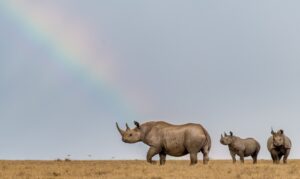
Ol Pejeta Conservancy Location
The conservancy is located on the equator west of Nanyuki, Kenya in Laikipia county. The conservancy is sandwiched between Mount Kenya and Aberdare Foothills.
The conservancy can be accessed via road and flight. By road, from Nairobi, it takes 4 hours. From Naivasha, via the Nyahururu and Nyeri route to enter the conservancy through Nyeri. The conservancy is accessed from the Rongai gate, the main gate or via Serat Gate on Rumuruti Road.
By flight, there are daily scheduled flights from Nairobi Wilson Airport. It then takes 45 minutes to the conservancy. Safarilink and Air Kenya offer these flight services to the conservancy.
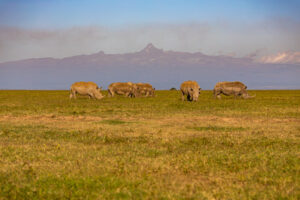
Ol Pejeta Conservancy entry fees
Ol Pejeta Conservancy charges are as follows,
Ol Pejeta Conservancy entry fees for EA Citizen
Adult- KES 2,000
Child- KES 1,000
Student- KES 500
Ol Pejeta Conservancy entry fees Rest of Africa
Adult- KES 3,500
Child- KES 1,750
Student- KES 500
Ol Pejeta Conservancy entry fees for International Residents
Adult- USD 110
Child- USD 55
Student- USD 32
Vehicle Entry includes;
Up to 6 seats KES1,000
7–12-seater- KES 5,000
15ord more seats- KES 12,000
Attractions in Kenya’s Ol Pejeta Conservancy
1. Wildlife
The Big Five animals are found in the conservancy- Lion, Cape buffalo, African Bush Elephant, African Leopard and Rhinoceros. The Black and Northern White Rhino live here.
The conservancy is a ‘Key 1’ black rhino population on the IUCN African Rhino Specialist Group categorization. It is one of the only 8 sanctuaries in Africa with this distinction.
In the Conservancy Kenya you will get to come across Baraka, a Black Rhino. Do you know an interesting fact about Baraka?
Baraka was born wild in Kenya’s Ol Pejeta Conservancy but lost sight after engaging in a fight. For his safety, he was relocated in an enclosure and now is the Rhino Ambassador.
Other Ol Pejeta Conservancy animals include Cheetah, Grevy’s Zebra, Baboons, Eland, Impala, Giraffes, Grant’s gazelle and many others. The conservancy has 300 bird species.
If you want to see many Elephants, visit the Elephant Kingdom, Amboseli National Park.
2. Sweet Waters Chimpanzee Sanctuary in Ol Pejeta Conservancy
The sanctuary was established in 1993 in a negotiated agreement between the conservancy, Kenya Wildlife Service and Jane Goodall Institute. The sanctuary serves as a lifelong refuge to orphaned and abused chimpanzees from West and Central Africa.
The sanctuary has been rescuing Chimpanzees since 1995 from traumatic situations and to date, there are 43 Chimpanzees.
The Chimpanzees in Ol Pejeta Conservancy in Kenya do spend their days climbing, socializing and exploring which is a mesmerizing experience to see.
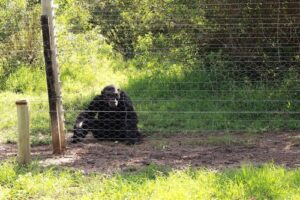
Activities in Ol Pejeta Conservancy Kenya
1. Game drives
This activity is one of the best experiences in sighting animals as in any beautiful national park in Kenya. Night game drives are unique experiences especially if you want to experience nocturnal animals in the African darkness.
Nocturnal animals you can see are Aardvarks, Zorilla and white-tailed mongoose.
2. Meet the Northern White Rhino
Have a unique opportunity to meet the last two remaining northern white rhinos in the conservancy. The fees for meeting the Northern White Rhinos are USD 70 per adult.
The times for meeting the Rhinos are from 8:30 am- 9:30 am, 11:00 am- 12:00 pm, 3:00 pm- 4:00 pm. and 4:30 pm- 5:30 pm.
3. Lion Tracking
In this activity, mostly researchers experience it but, you can do so at a fee. Lion Tracking fees at Ol Pejeta Conservancy are USD 70. The times for engaging in this activity include from 6:30 am to 8:30 am and from 3:30 pm to 5:30 pm.
4. Dog Tracking
Want to learn how the 14+ dogs in the conservancy have been turned into anti-poaching patrollers? For USD 70, experience this activity from 8:30 am.
5. Meet the local community
The conservancy partners with local communities, ensuring security and offering recruitment opportunities. From USD 70, On Saturday between 10:30 am- and 12:30 pm, meet the conservancy’s neighbours.
You can also do this at Maasai Mara National Reserve, and Amboseli National Parks.
Other activities and their charges include;
- Chimpanzees visit in the sanctuary- USD 70. From 6:30 am-8:30 am and 3:30 pm-5:30 pm.
- Rhino monitoring and identification- USD 70. From 6:30- 8:30 am and 3:30 pm- 5:30 pm.
- Livestock- wildlife Integration- USD 70. From 8:00 am – 10:00 am.
Accommodations in Kenya’s Ol Pejeta Conservancy
Where to stay in Ol Pejeta Conservancy? There are tented camps, lodges and homestays.
Here, you can find the best Airbnb’s in Nanyuki. The accommodations in Ol Pejeta Conservancy include;
- Kicheche Laikipia Camp
- Mutara Camp
- Ol Pejeta Bush Camp
- Ol Pejeta Safari Cottages
- Pelican House
- Porini Rhino Camp
- Sanctuary Tambarare
- Sweetwaters Serena Camp
- River Camp
- The Stables
- Fairmont Mount Kenya Safari Club– takes 1 hr 6 minutes to Ol Pejeta Conservancy

Campsites in Ol Pejeta Conservancy Nanyuki Kenya include;
- Ewaso Campsite
- Hippo Hide
- Mbogo Campsite
- Murera Donga Campsite
- Scott’s Hide Campsite
- Ol Lerai Campsite
- Spoonbill Campsite
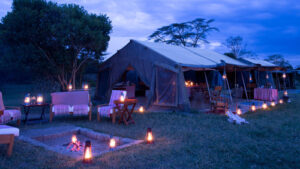
Nearby accommodation is the Mount Kenya Wildlife Estate.
Book with Naicef for great deals and homestays and accommodations near Ol Pejeta Conservancy Kenya.
Conclusion
This beautiful conservancy is located in Nanyuki, Kenya. The best of Ol Pejeta Conservancy animals are;
- Black Rhinos
- White Rhinos
- Chimpanzees- this is the only place in Kenya where you will find them!
Naicef is the best tour company in Kenya because we focus on;
Customer Centricity: Curating the best tours for each traveller.
Quality: Crafting African experiences in quality for the best memorable safaris.
Professionalism: Our professional team creates long-lasting relationships with all travel partners.
For every safari/ tour you take with Naicef, you contribute to Sustainable tourism through our sustainable environmental and local community programs. Naicef focuses on raising responsible tourists.
Did you know Naicef is the best travel blog in Africa? Enjoy the Best Safari Travel Blog!
For Ol Pejeta Conservancy contact Naicef via my@naicef.com or +254799922277
You can as well opt for our Naicef savings plan to plan your visit to any national parks, national reserves, sanctuaries and conservancies in Kenya.
